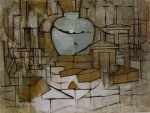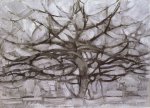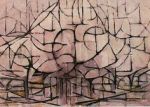Fascinating Rythms
April 29, 2019 § Leave a comment
 Piet Mondrian, 1872-1944
Piet Mondrian, 1872-1944
“… All you need now is to stand at the window and let your rhythmical sense open and shut, open and shut, boldly and freely, until one thing melts in another, until the taxis are dancing with the daffodils, until a whole has been made from all these separate fragments.” -Virginia Woolf, A Letter to a Young Poet
Children of a certain age are strangely masterful in wielding a brush. They don’t have to be told what to do, or how to do it. Mark-making is a deep, instinctual, and self-sufficient pleasure as old as the human race. Some manage to hold on to the natural feeling for rhythm, movement and relationship in art making as they leave childhood, but too often it becomes buried in the adult whose only model for form-making is the smooth, indiscriminately detailed facture of photography. Re-awakening these dynamic instincts should be as important a goal to the student of painting as learning to see and mix color.
The experiments of artists in the early 20th century are instructive for unpacking this business of rhythm and movement in painting. Abstract forces exist in all painting, and in any view of nature, but they often are disguised, especially to the novice, by the dominance of illusionistic concerns. In the early decades of the 20th century, just as the theories of Einstein began to undo and reshape traditional notions of time and space, Modern art movements such as Cubism, Futurism, De Stjil, and Constructivism began to reorient the focus of painting away from the outward appearance of solid matter to the internal dynamics of pictorial structure. The fractured spaces of George Braque and Picasso, and the reductive verticals, horizontals and diagonals of Theo Van Doesburg and Piet Mondrian began to speak of an energetic reality behind appearances.
Jack Boul, one of my teachers in grad school, made a comment that I think brilliantly frames a fundamental problem of painting. He said, “We sense the structure in early Mondrian. His line first represents a vertical, then a division of the picture space, then a tree. Most people just paint the tree.”
If the Renaissance, and the centuries of pictorial traditions it fostered, were based on the assumption of a solid world composed of discreet entities in a measurable space, the new spirit in painting was informed by the scientific revelation that matter is not solid at all – it’s energy. E=mc2. Painting’s formal language becomes a corollary to this new vision – the structured, dynamic rhythms of the physical universe played out on the artist’s canvas.

















